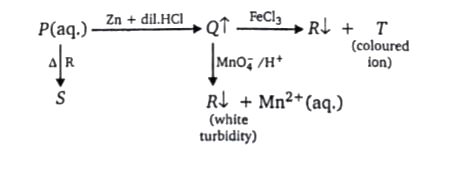There are five species P, Q, R, S and T. Spectroscopical analysis shows that P,Q and R are homonuclear diatomic species and have their bond order 2.5, 1.5 and 2.5 respectively and rest two species S and T are heteronuclear diatomic species and have bond order 3 and 2 respectively. All homonuclear diatomic species are paramagnetic and all heteronuclear species are diamagnetic in nature. P, R , S and T are monocovalent positive ion and Q is monovalent negative ion:
Q. According to given information the incorrect match is :
P=N+2
R=O+2
S=CO+
T=CN+
The correct Answer is:C
To solve the problem, we need to analyze the given information about the species P, Q, R, S, and T, focusing on their bond orders and magnetic properties. We will also identify the incorrect match based on the bond orders.
1. Identify the Species and Their Properties:
- P, Q, R are homonuclear diatomic species with bond orders:
- P: Bond order = 2.5
- Q: Bond order = 1.5
- R: Bond order = 2.5
- S and T are heteronuclear diatomic species with bond orders:
- S: Bond order = 3
- T: Bond order = 2
2. Determine the Magnetic Properties:
- All homonuclear diatomic species (P, Q, R) are paramagnetic.
- All heteronuclear diatomic species (S, T) are diamagnetic.
3. Identify the Charge of Each Species:
- P, R, S, and T are monopovalent positive ions.
- Q is a monovalent negative ion.
4. Match Each Species with Known Molecular Species:
- For P (Bond order 2.5): This matches with N₂⁺ (bond order = 2.5).
- For Q (Bond order 1.5): This matches with O₂⁻ (bond order = 1.5).
- For R (Bond order 2.5): This matches with O₂⁺ (bond order = 2.5).
- For S (Bond order 3): This should match with CO⁺ (bond order = 3.5).
- For T (Bond order 2): This matches with CN⁺ (bond order = 2).
5. Identify the Incorrect Match:
- The match for S is incorrect because S has a bond order of 3, while CO⁺ has a bond order of 3.5. Therefore, S does not correctly match with CO⁺.
Conclusion:
The incorrect match is for species S, which was matched with CO⁺. Thus, the answer is that the incorrect match is option 3.
---
- P, Q, R are homonuclear diatomic species with bond orders:
- P: Bond order = 2.5
- Q: Bond order = 1.5
- R: Bond order = 2.5
- S and T are heteronuclear diatomic species with bond orders:
- S: Bond order = 3
- T: Bond order = 2
- All homonuclear diatomic species (P, Q, R) are paramagnetic.
- All heteronuclear diatomic species (S, T) are diamagnetic.
- P, R, S, and T are monopovalent positive ions.
- Q is a monovalent negative ion.
- For P (Bond order 2.5): This matches with N₂⁺ (bond order = 2.5).
- For Q (Bond order 1.5): This matches with O₂⁻ (bond order = 1.5).
- For R (Bond order 2.5): This matches with O₂⁺ (bond order = 2.5).
- For S (Bond order 3): This should match with CO⁺ (bond order = 3.5).
- For T (Bond order 2): This matches with CN⁺ (bond order = 2).
- The match for S is incorrect because S has a bond order of 3, while CO⁺ has a bond order of 3.5. Therefore, S does not correctly match with CO⁺.
The incorrect match is for species S, which was matched with CO⁺. Thus, the answer is that the incorrect match is option 3.
Topper's Solved these Questions
- CHEMICAL BONDING (ADVANCED)Book:VK JAISWAL ENGLISHChapter:CHEMICAL BONDING (ADVANCED)Exercise:ONE OR MORE ANSWER IS/ARE CORRECT
Explore 78 Videos
- CHEMICAL BONDING (ADVANCED)Book:VK JAISWAL ENGLISHChapter:CHEMICAL BONDING (ADVANCED)Exercise:MATCH THE COLUMN
Explore 21 Videos
- CHEMICAL BONDING (ADVANCED)Book:VK JAISWAL ENGLISHChapter:CHEMICAL BONDING (ADVANCED)Exercise:Level 2
Explore 150 Videos
- CHEMICAL BONDING (BASIC)Book:VK JAISWAL ENGLISHChapter:CHEMICAL BONDING (BASIC)Exercise:SUBJECTIVE PROBLEMS
Explore 54 Videos
Similar Questions
Knowledge Check
Which of the following species is paramagnetic in nature ?
AH2BLi2CB2DN2
The species having diamagnetic nature and bond order 1.0 is
View SolutionWhich of the following species is diamagnetic in nature?
View SolutionWhich of the following species is paramagnetic in nature?
View Solution
Q. Species P and S are respectively:
View SolutionThe pair of species with the same bond order is :
View SolutionThe pair of species with the same bond order is :
View SolutionThe species with fractional bond order is :
View Solution